-
Updated 2023-07-12: Hello, Guest! Welcome back, and be sure to check out this follow-up post about our outage a week or so ago.
You are using an out of date browser. It may not display this or other websites correctly.
You should upgrade or use an alternative browser.
You should upgrade or use an alternative browser.
hey B M O W ! :-) Apple IIgs support - Floppy Emu?
- Thread starter uniserver
- Start date
I haven't found any documents clarifying the drive select pins role with 3.5" drives. I have to disassemble a drive and see how the pins are routed on the daisy chain board.
Looking at the Mac Plus schematics, it looks like pin 16 is head select and its controlled by the 6522 VIA. Besides the change in what chip is controlling it, it should use the same logic across both machines.
On Macs, the Drive Select 1 signal from the IWM is wired to the internal floppy header and Drive Select 2 is wired to pin 17 of the external floppy connector. On the IIgs, Drive Select 1 signal from the IWM is wired to pin 17 and Drive Select 2 is wired to pin 9.
I highly suspect that the 3.5 Disk Enable pin has logic on the floppy drive end. If the pin goes high, the Apple 3.5" drive responds to the machine, if its low it ignores it since the instructions are bound for 5.25" drives. What makes matters confusing is how does the Apple 3.5" drive work on a Mac if this pin is grounded and unused?
Looking at the Mac Plus schematics, it looks like pin 16 is head select and its controlled by the 6522 VIA. Besides the change in what chip is controlling it, it should use the same logic across both machines.
On Macs, the Drive Select 1 signal from the IWM is wired to the internal floppy header and Drive Select 2 is wired to pin 17 of the external floppy connector. On the IIgs, Drive Select 1 signal from the IWM is wired to pin 17 and Drive Select 2 is wired to pin 9.
I highly suspect that the 3.5 Disk Enable pin has logic on the floppy drive end. If the pin goes high, the Apple 3.5" drive responds to the machine, if its low it ignores it since the instructions are bound for 5.25" drives. What makes matters confusing is how does the Apple 3.5" drive work on a Mac if this pin is grounded and unused?
uniserver
Well-known member
the only thing i have to offer is that i did notice when using the Apple® 800k floppy drive with the Macintosh 128k.
it works. @ as 400k drive.
but if i install that same 800k floppy drive internally i have to make sure to use a special cable that has pin 9 and pin 20 cut.. then the drive works. or else it will try to burn out the eject motor.
So the bridge board in the Apple® 3.5 800k external must also disable pin 9 and 20 as well. I don't know if that helps anything… lol
it works. @ as 400k drive.
but if i install that same 800k floppy drive internally i have to make sure to use a special cable that has pin 9 and pin 20 cut.. then the drive works. or else it will try to burn out the eject motor.
So the bridge board in the Apple® 3.5 800k external must also disable pin 9 and 20 as well. I don't know if that helps anything… lol
bigmessowires
Well-known member
That would be interesting to see.I haven't found any documents clarifying the drive select pins role with 3.5" drives. I have to disassemble a drive and see how the pins are routed on the daisy chain board.
It's labeled HDSEL on some diagrams, but on the Mac it's just a generic output pin (input to the floppy drive), used in combination with the other pins to read/write one of the 16 internal drive registers. That's the part that Floppy Emu needs the CPLD for.Looking at the Mac Plus schematics, it looks like pin 16 is head select and its controlled by the 6522 VIA. Besides the change in what chip is controlling it, it should use the same logic across both machines.
Exactly. My proposed pulldown solution would work, I think, but it feels too weird to be the right solution.If the pin goes high, the Apple 3.5" drive responds to the machine, if its low it ignores it since the instructions are bound for 5.25" drives. What makes matters confusing is how does the Apple 3.5" drive work on a Mac if this pin is grounded and unused?
I tried hacking pin 4 off one of my Floppy Emus, but the spacing is too tight and I couldn't find any good way to do it without damaging stuff. If you have one of those extension cables from IEC, you could try cutting the wire for pin 4, and see how that affects Floppy Emu with the IIgs.let me know if and what you want me to test on the IIgs
Last edited by a moderator:
The daisy chain board is the key and likely controls the drive select logic. I don't want to be responsible for any damage, but its likely the floppy emulator will work on a IIgs, if you connect its internal header to a Apple 3.5" drive's daisy chain board. Using a multimeter, the 3.5 Select and Drive Select lines don't seem to be directly passed through the board. Pin 4 is not wired to chassis ground either.
Just a thought in my head on possible daisy chain board logic.
At the IIgs disk port:
If pin 4 is grounded on the port, first drive is 5.25" thus no 3.5" drives detected
If pin 4 is not grounded on the port and there is a ground present on some random pin, first drive is 3.5", probe to see if there are two drives
3.5" drive in the chain:
If pin 4 is grounded on daisy chain port, drive is 5.25", route drive select 1 signal to pin 17, only activate if input pin 4 is low from computer.
If pin 4 is not grounded on daisy chain port and there is a ground present on some random pin, drive is 2nd 3.5", route drive select 2 signal from pin 9 to pin 17 (this is how the drive avoids receiving the damaging PWM signal on a compact Mac, it never makes it to the floppy drive to begin with!)
If pin 4 is not grounded and there is no ground present on some random pin, drive is last in chain
This configuration only supports 2x3.5" drives per IIgs, since there is no drive select signal available on pin 9 to the second drive on the chain.
5.25" drives are dumb, they just pass input pin 9 to daisy chain port pin 17. Detecting one or two 3.5" drives connected is likely done by the IIgs firmware. 5.25" don't have auto detection due to their legacy nature.
At the IIgs disk port:
If pin 4 is grounded on the port, first drive is 5.25" thus no 3.5" drives detected
If pin 4 is not grounded on the port and there is a ground present on some random pin, first drive is 3.5", probe to see if there are two drives
3.5" drive in the chain:
If pin 4 is grounded on daisy chain port, drive is 5.25", route drive select 1 signal to pin 17, only activate if input pin 4 is low from computer.
If pin 4 is not grounded on daisy chain port and there is a ground present on some random pin, drive is 2nd 3.5", route drive select 2 signal from pin 9 to pin 17 (this is how the drive avoids receiving the damaging PWM signal on a compact Mac, it never makes it to the floppy drive to begin with!)
If pin 4 is not grounded and there is no ground present on some random pin, drive is last in chain
This configuration only supports 2x3.5" drives per IIgs, since there is no drive select signal available on pin 9 to the second drive on the chain.
5.25" drives are dumb, they just pass input pin 9 to daisy chain port pin 17. Detecting one or two 3.5" drives connected is likely done by the IIgs firmware. 5.25" don't have auto detection due to their legacy nature.
uniserver
Well-known member
merry christmas and happy new year.
the first one i loaded, don't know what it was, but it booted and then stalled @ track 33.

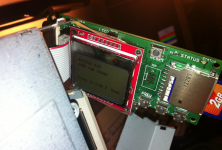
so i thought great! oh well !!!! its working!
so then i selected install.dsk witch looks to be gos 6.01 install disk
it works and boots up… my IIgs is acting up… there are some bad caps on the main board that i need to tend to at one point..
but the thing works!! using the 800k bridge board.
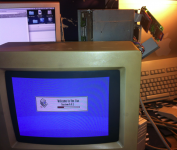
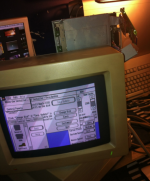
the first one i loaded, don't know what it was, but it booted and then stalled @ track 33.


so i thought great! oh well !!!! its working!
so then i selected install.dsk witch looks to be gos 6.01 install disk
it works and boots up… my IIgs is acting up… there are some bad caps on the main board that i need to tend to at one point..
but the thing works!! using the 800k bridge board.


Is the machine randomly crashing? Usually dumps to the "*" monitor prompt. Capacitors usually aren't a problem in these, but its possible after 25 years of service. Check the power supply too, they get dodgy with age.
Anyway, that confirms the daisy chain board in the Apple 3.5" drive is what handles the drive select logic.
Anyway, that confirms the daisy chain board in the Apple 3.5" drive is what handles the drive select logic.
uniserver
Well-known member
there are visually bad caps on the board they are leaking 
i have another Iigs in the garage with 2.25 megs ram. but too lazy to go get it.
what happens is if i click on any of the control panel items more then once it seems i hear the IIgs reboot beep… and the screen gui just locks, i think i can still move the mouse but i can't remember.. it was late and i was super tired. -- glad it works though… so i would assume this means we need to disconnect pin 4 on the floppy emu?
i have another Iigs in the garage with 2.25 megs ram. but too lazy to go get it.
what happens is if i click on any of the control panel items more then once it seems i hear the IIgs reboot beep… and the screen gui just locks, i think i can still move the mouse but i can't remember.. it was late and i was super tired. -- glad it works though… so i would assume this means we need to disconnect pin 4 on the floppy emu?
bigmessowires
Well-known member
Wait, what? It works? That's awesome!
What does the daisy chain board do in a normal IIgs system, and where does it go in the chain?
It's possible that's due to a problem with the floppy emulation not being totally IIgs-compatible, if clicking on a control panel item causes some disk access. What happens if you run this IIgs with a real floppy disk?what happens is if i click on any of the control panel items more then once it seems i hear the IIgs reboot beep… and the screen gui just locks
What does the daisy chain board do in a normal IIgs system, and where does it go in the chain?
bigmessowires
Well-known member
Does the IIgs need an eject button? Sorry for the dumb questions - I've never used or even seen a IIgs. But if it doesn't do disk eject in software like the Mac, then Floppy Emu would need an eject button added to make it play nice with the IIgs, right?
bigmessowires
Well-known member
Now I'm confused. Is the daisy chain board part of the 800k IIgs floppy drive, or is it something different? If it's part of the drive, then why didn't Floppy Emu work when you first tried connecting it to the drive's pass-through port?i even connected the emu to the back of the 800k IIgs floppy drive… booted GOS, and does the same thing.
uniserver
Well-known member
yeah the apple® 800k 3.5 disk drive has a eject button on it.
not sure if the iigs needs it?
I am like you i know almost nothing about the IIGS
I had it on the shelf for a year and a half and never even turned it on to test it. LOL
i have used more in the last week then the whole time i'v owned it
lastnight with the floppy emu and that Disk one install of gos 6.0.1 was the first time i have physically seen it
yeah i know its bad.
mcdermd said its ok though because i'm a mac dude. not apple II guy
i used disk copy to make a 800k gos 6.0.1 disk
and tried to boot it normal and it said something about cannot boot pro dos…
so looks like the Floppy emu is working better then the normal floppy drive…
not sure if the iigs needs it?
I am like you i know almost nothing about the IIGS
I had it on the shelf for a year and a half and never even turned it on to test it. LOL
i have used more in the last week then the whole time i'v owned it
lastnight with the floppy emu and that Disk one install of gos 6.0.1 was the first time i have physically seen it
yeah i know its bad.
mcdermd said its ok though because i'm a mac dude. not apple II guy
i used disk copy to make a 800k gos 6.0.1 disk
and tried to boot it normal and it said something about cannot boot pro dos…
so looks like the Floppy emu is working better then the normal floppy drive…
I wonder if the eject button will "eject" the mounted disk image if pressed. Does the drive activity light work with the emulator? Both the light and the eject button connect to the daisy chain board. The eject button is software controlled, although unlike a Mac, you can arbitrarily eject a disk while its mounted on the GS/OS desktop. It basically does the equivalent of a "Command-Shift-3" although when connected to a Mac, the eject button doesn't function at all. The button is needed to change disks in ProDOS as some software doesn't software auto eject floppies when requesting another disk be inserted. GS/OS is similar to MacOS and even uses the same dialogs when it wants another disk inserted. The machine has full software eject like the Mac, but you can eject on command by pushing the button if you wish.
Uniserver's crashing problem is likely related to the bad capacitors causing system stability problems. If GS/OS had a problem accessing the disk, it would have crashed well before reaching the installer as the boot process loads quite a few files from disk (a real drive seeks A LOT on boot). It would have also kicked back a system error regarding reading disks with the sliding Apple. Dumping to monitor usually means memory is getting trashed.
Inside the drive is a raw Sony DSDD floppy drive, the same as found in period Macs. It is connected to a board that holds the DB-19 pass-through to connect another drive and the cable that goes to the computer. This board also seems to handle the eject button in addition to interpreting the "3.5DISK" signal on pin 4 and the Drive Select Signals. On a Mac, its just dead weight.Now I'm confused. Is the daisy chain board part of the 800k IIgs floppy drive, or is it something different? If it's part of the drive, then why didn't Floppy Emu work when you first tried connecting it to the drive's pass-through port?
Uniserver's crashing problem is likely related to the bad capacitors causing system stability problems. If GS/OS had a problem accessing the disk, it would have crashed well before reaching the installer as the boot process loads quite a few files from disk (a real drive seeks A LOT on boot). It would have also kicked back a system error regarding reading disks with the sliding Apple. Dumping to monitor usually means memory is getting trashed.
bigmessowires
Well-known member
I think I get it. This board has a cable to the IIgs, an IDC-20 connector for the floppy drive, and a DB-19 pass-through so you can optionally daisy-chain a second floppy drive, right? So Floppy Emu didn't work when connected to that DB-19 pass-through, but did work when connected to the IDC-20, replacing the real drive mechanism. Makes sense.Inside the drive is a raw Sony DSDD floppy drive, the same as found in period Macs. It is connected to a board that holds the DB-19 pass-through to connect another drive and the cable that goes to the computer. This board also seems to handle the eject button in addition to interpreting the "3.5DISK" signal on pin 4 and the Drive Select Signals.
Given what you've told me, I'd guess it does. I can also add an eject feature to the firmware, that's pretty easy. It might be a little confusing for Mac users to see an "eject" option, though.I wonder if the eject button will "eject" the mounted disk image if pressed.
So yeah, I'm very interested in what modifications to Floppy Emu would be necessary to make it work on the IIgs without requiring that daisy-chain board. Ideally while still maintaining interoperability with other real 3.5 drives in the chain. Does anyone have a high-res photo of the daisy chain board? Does it have any ICs on it, or is it just a bunch of passive components?
Unfourtunatly this board is far from simple in design. It has a ton of passives, plus a Sony CXD1085B IC. Also the later Apple FDHD external drive (G7287) has a slightly different board that lacks the pass through DB-19. This drive was mostly intended for the Mac, but works with the Apple FDHD controller card for the Apple II as well.
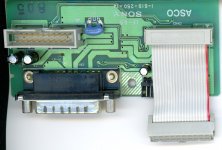

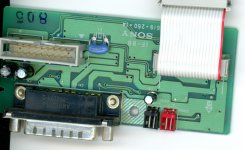



Similar threads
- Replies
- 11
- Views
- 1K
- Replies
- 6
- Views
- 377
- Replies
- 7
- Views
- 799
- Replies
- 36
- Views
- 2K
